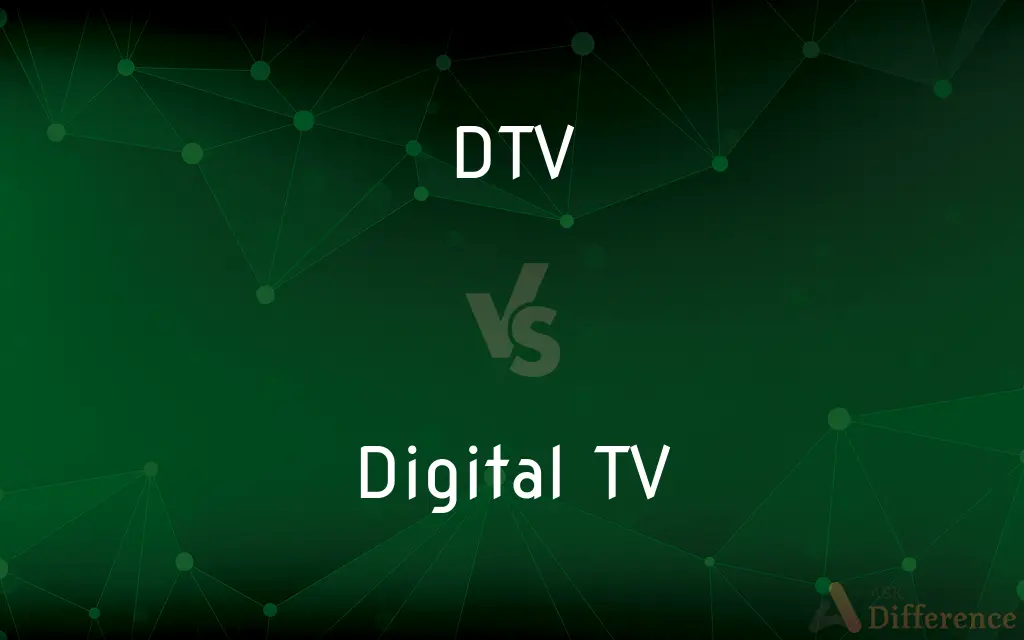DTV vs. Digital TV — What's the Difference?
By Tayyaba Rehman — Published on January 30, 2024
DTV (Digital Television) is a broad term for broadcasting television signals in digital format, while Digital TV often refers to the actual TV set or system receiving digital signals.

Difference Between DTV and Digital TV
Table of Contents
ADVERTISEMENT
Key Differences
DTV (Digital Television) is a term that encompasses the entire technology and process of transmitting television content in digital format, including various standards like ATSC, DVB, and ISDB. This digital transmission ensures better picture and sound quality compared to traditional analog TV. On the other hand, when people refer to Digital TV, they are often talking about the television sets or systems that are capable of receiving and decoding digital signals transmitted by broadcasters.
In the context of DTV, it includes both the transmission and reception aspects of digital broadcasting. This concept is more about the technology and standards behind the broadcasting process. Whereas, Digital TV often specifically refers to the consumer electronics - the television sets that are equipped to handle and display digital signals. This can include features like integrated digital tuners or the ability to connect to digital set-top boxes.
DTV represents a broad shift in the broadcasting industry from analog to digital transmission, allowing for more channels in the same bandwidth and supporting high-definition (HD) content. This transition to DTV has been a significant technological advancement. Conversely, Digital TV focuses on the end-user experience, highlighting the capabilities of TV sets to receive HD content, display improved picture and sound quality, and offer additional features like electronic program guides.
The implementation of DTV standards varies globally, with different countries adopting different digital broadcasting standards (like ATSC in the USA, DVB in Europe). This shift has implications for broadcasting infrastructure and regulation. In contrast, Digital TV is about the compatibility of television sets with these various standards, ensuring that viewers can access and view digital broadcasts irrespective of their geographical location.
Finally, DTV is a broader concept that not only includes the transmission of TV signals in digital format but also the associated technologies like compression and modulation techniques. In contrast, Digital TV is more focused on the consumer technology and how television sets have evolved to accommodate and enhance the digital broadcasting experience.
ADVERTISEMENT
Comparison Chart
Definition
Broad term for digital broadcasting technology and standards
Refers to TV sets capable of receiving digital signals
Focus
Encompasses transmission and reception technology
Focuses on consumer electronics and user experience
Representation
Shift in broadcasting from analog to digital
Evolution of TV sets to adapt to digital broadcasting
Global Standards
Various standards like ATSC, DVB, ISDB
Compatibility with different digital broadcasting standards
Associated Technologies
Includes digital compression and modulation techniques
Primarily about display capabilities and set-top boxes
Compare with Definitions
DTV
DTV is the transmission of television signals using digital encoding.
The switch from analog to DTV improved the quality of broadcast television significantly.
Digital TV
Digital TV is characterized by its ability to display high-definition content.
The clarity of high-definition channels on her digital TV was stunning.
DTV
DTV represents a significant technological shift in how television content is transmitted.
The transition to DTV allowed broadcasters to offer multiple channels in the same bandwidth.
Digital TV
Digital TV refers to television sets designed to receive and display digital signals.
Her new digital TV provided a much clearer image than her old analog set.
DTV
DTV enhances television broadcasting with better picture and sound quality.
Viewers noticed a marked improvement in both audio and video quality with the advent of DTV.
Digital TV
It involves TV sets with integrated digital tuners or compatibility with set-top boxes.
Buying a digital TV eliminated the need for an external set-top box.
DTV
It includes the methods and infrastructure for broadcasting digital television signals.
DTV infrastructure upgrades were necessary for the transition from analog.
Digital TV
It includes features like electronic program guides and improved sound quality.
His digital TV's program guide made it easy to find his favorite shows.
DTV
It encompasses digital broadcasting standards like ATSC and DVB.
DTV standards such as DVB-T have enabled more efficient use of broadcasting frequencies.
Digital TV
Digital TV enhances the viewer's experience with advanced display technology.
The LED screen of her digital TV provided vibrant colors and deep contrasts.
Common Curiosities
What does DTV stand for?
DTV stands for Digital Television, referring to the digital broadcasting of TV signals.
Can Digital TVs receive analog signals?
Modern digital TVs generally cannot receive analog signals without a converter.
Why was the switch to DTV made?
The switch to DTV was made to improve picture and sound quality and to allow more efficient use of broadcasting bandwidth.
What are common DTV standards?
Common DTV standards include ATSC, DVB, and ISDB, varying by region.
Are all flat-screen TVs Digital TVs?
Most modern flat-screen TVs are Digital TVs, but it's best to check the specifications to be sure.
Do I need a set-top box with a Digital TV?
If the Digital TV has an integrated tuner compatible with the broadcasting standard in your area, you may not need a set-top box.
Is Digital TV the same as a smart TV?
No, Digital TV refers to the ability to receive digital signals, while smart TVs also offer internet connectivity and apps.
How has DTV improved broadcasting?
DTV has improved broadcasting by enabling high-definition content, better sound quality, and more channel options.
What features do modern Digital TVs have?
Modern Digital TVs often feature high-definition display, integrated tuners, electronic program guides, and sometimes smart capabilities.
Is DTV available in rural areas?
DTV availability depends on the broadcasting infrastructure, but it's generally available in most areas.
Can I get international channels on a Digital TV?
This depends on the broadcasting standards and available channels in your region.
Can DTV signals be compressed?
Yes, DTV signals are often compressed using techniques like MPEG-2 or MPEG-4 to maximize bandwidth efficiency.
How do I know if my TV is DTV-compatible?
Check for a label or specification indicating compatibility with digital broadcasting standards like ATSC or DVB.
Are there different types of Digital TVs?
Yes, there are various types, including LED, LCD, and OLED Digital TVs, each with different display technologies.
Do Digital TVs need an antenna?
Yes, if you're receiving over-the-air DTV broadcasts, an antenna is required.
Share Your Discovery

Previous Comparison
.380 vs. .38 Special
Next Comparison
E Coli vs. Serratia MarcescensAuthor Spotlight
Written by
Tayyaba RehmanTayyaba Rehman is a distinguished writer, currently serving as a primary contributor to askdifference.com. As a researcher in semantics and etymology, Tayyaba's passion for the complexity of languages and their distinctions has found a perfect home on the platform. Tayyaba delves into the intricacies of language, distinguishing between commonly confused words and phrases, thereby providing clarity for readers worldwide.














































